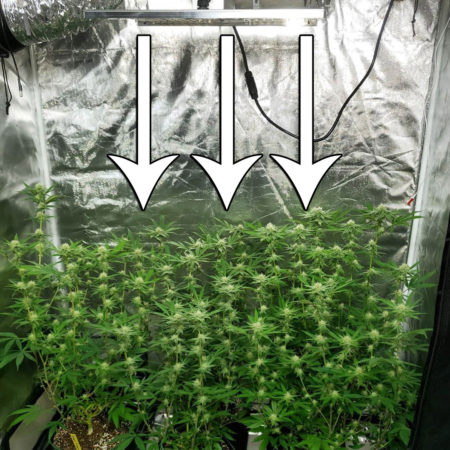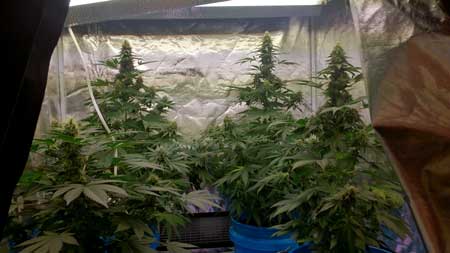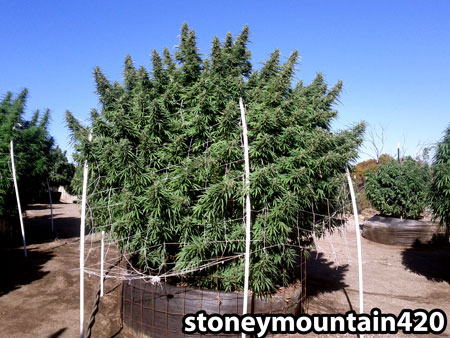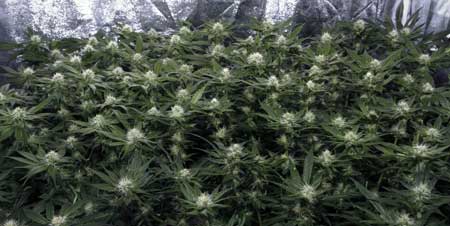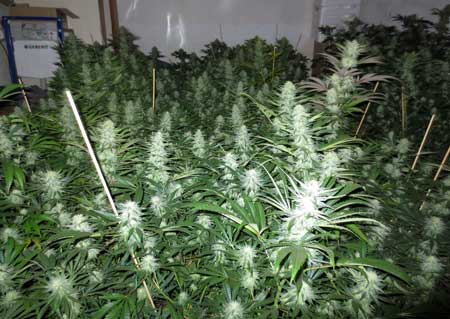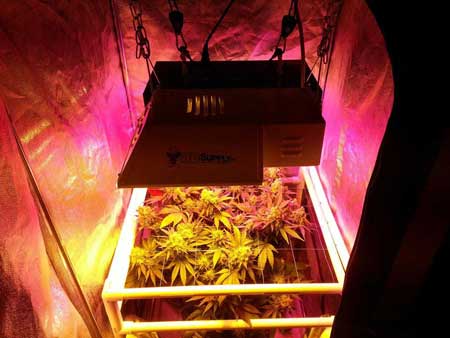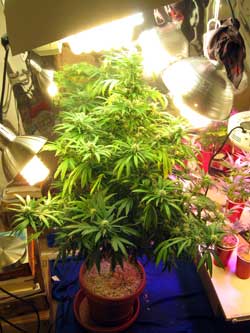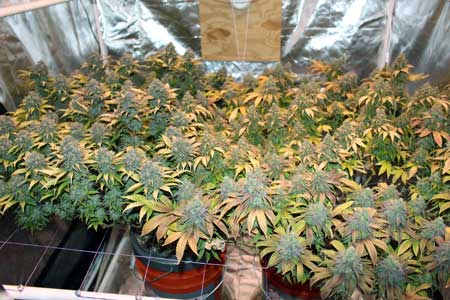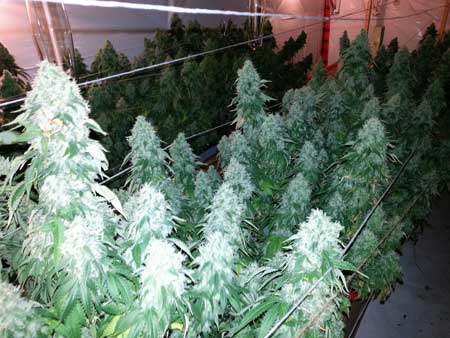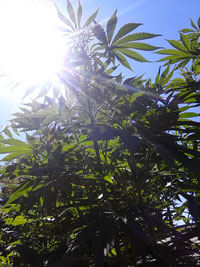by Nebula Haze
Table of Contents
Side Lighting vs Supplemental Lighting
When Is Side Lighting a Good Idea?
Is Side or Supplemental Lighting Worth It For Cannabis Growers?
When growing a cannabis plant indoors, light usually comes from a grow light located at the top of the grow space. This means all the light is beaming down on the plant from above.
Most grow lights point light straight down at the plants
You may have noticed that by harvest time, buds close to the grow light are often the biggest. Should you give more light from the sides to increase the size of lower buds?
Does it make sense to add side lighting indoors? Can you copy the sun and give light from the sides to increase yields?
Is Side Lighting Worth It for Cannabis Plants?
So is side lighting worth it for indoor cannabis growers? The answer is unsatisfactory…
Maybe…
Side lighting can be helpful in certain situations, but it’s often unnecessary and may reduce yields/watt compared to adding light from above. Why is that?
It has to do with how cannabis plants respond to their environment. Although buds tend to grow bigger with more light, cannabis plants still favor the upper buds. A cannabis plant can “tell” which buds are at the top of the plant and puts more energy into these “high value” buds even when everything else is equal.
Even when cannabis gets the same amount of light from top to bottom, like with these old-fashioned Phototrons, the top buds are still bigger. That’s just how cannabis plants roll 🙂
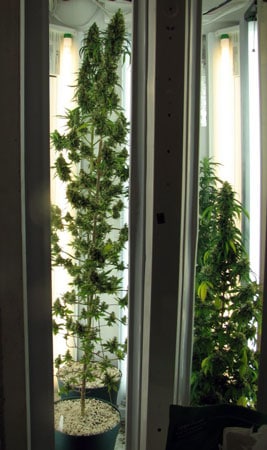
Cannabis plants naturally put the most energy into upper buds even when the plant is getting tons of light from the sides. Growers have competing theories about exactly why. Perhaps the top buds are most likely to get pollinated by the wind in nature.
To take advantage of this natural tendency, indoor growers often train plants to produce many top buds near the light (as opposed to adding side lighting). This ends up getting you more “bang for your buck” because you’ll get better yields/watt with free plant training than you would with side lighting.
Because upper buds grow the biggest, growers often train their plants to grow bud sites on a flat, table-top shaped canopy. This puts more bud sites at the top of the plant close to the grow light.
Growing “wide” cannabis plants with light on top results in better yields/watt than growing “tall” plants with the same amount of light on the sides
Side Lighting vs Supplemental Lighting
- Side Lighting means specifically targeting the sides of the plant with light to try to increase bud size on the sides.
- Supplemental Lighting means you’re trying to increase overall light levels or change the light spectrum. Supplemental lighting isn’t about giving light from the sides; in fact, generally supplemental lighting is given from above the plant because that gives you more bang for your buck.
Supplemental lighting is common in greenhouses. If you have a spot in your yard that only gets good direct light for a few hours a day, or if you have a lot of cloudy weather at your location, you could supplement with extra light from a grow light while still taking advantage of the free light you’re getting from the sun.
Example of a Greenhouse Supplemented by LED Grow Lights to Increase Yields (A Light Mover Moves Grow Lights Back and Forth)
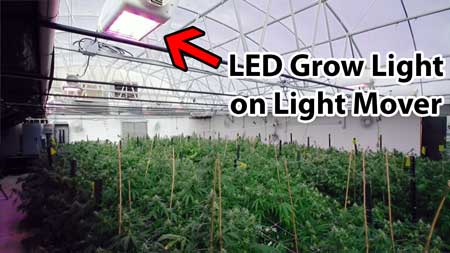
Another common reason growers use supplemental lighting is to alter the light spectrum, or “color” of the light. Each light spectrum affects how your plant grows and some growers are using the power of LED grow lights (which allow you to choose the exact spectrum) to supplement either outdoor light or the light of other grow lights like HPS. These days it’s pretty common to see growers use LED grow lights to achieve a specific spectrum; it’s also common to see growers combine their LED panel with an HPS grow light to help get better yields and increased flower production.
This grower added red-heavy LED grow lights to help encourage flowering
Supplemental lighting can be a great choice in a lot of situations, but it’s not exactly the same as side lighting, which tends to be less useful most of the time.
When Is Side Lighting a Good idea?
Side lighting can be a good idea with fluorescent grow lights like CFLs and possibly T5 grow lights with untrained plants. This is because these types of light don’t reach far down into the plant. In fact, the light from fluorescents is so weak that it’s only good for a few inches. By the time a plant is more than a foot away the light is pretty much useless as far as bud fattening is concerned. Because of these constraints, side lighting can help make sure all buds are within a few inches of a light bulb.
Sometimes side lighting can help with fluorescent lights like CFLs, especially on an untrained plant where most of the buds are far from the top of the plant
However, if you train your cannabis plant to grow short and flat you can increase your yields with the same amount of light because you’ll be able to make sure every main bud is located towards the top of the plant while also getting full light levels.
In other words, even with weak grow lights, you’ll get far better yields by growing plants that are wide and flat as opposed to utilizing side lighting.
These buds got really fat even though they were grown under a small T5 grow light because every bud was near the top and close to the light, due to being trained to grow flat along a screen.
When you get to really strong types of grow lights like HPS and LEDs, their light reaches deep down into the plant. This gives you long, thick buds and without any type of side lighting.
To sum it up, it’s good to get plenty of light to your buds near no matter where they’re located on the plant, as buds that are exposed to light and air tend to grow the biggest. But ultimately you’ll get better yields/watt simply by making sure all main buds are located near the top of the plant and shining light directly down on them from above.
Learn how to train plants to grow flat and wide
(and get the best yields possible with your grow lights!)
Ready to learn more? Learn how to increase….

